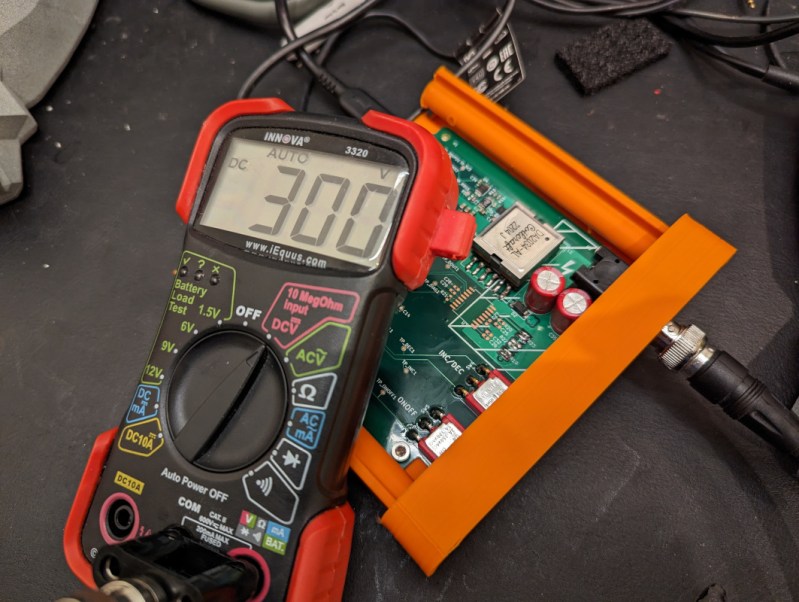Those who work in different spaces may have different definitions of the term “high voltage”. For someone working on the GPIO pins of a Raspberry Pi it might be as little as 5 volts, someone working on a Tesla coil might consider that to be around 20 kV, and an electrical line worker might not reference something as HV until 115 kV. What we could perhaps all agree on, though, is that getting 300 volts out of a USB power supply is certainly a “high voltage” we wouldn’t normally expect to see in that kind of context, but [Aylo6061] needed just such a power supply and was eventually able to create one.
In this case, the high voltages will eventually be used for electrophoresis or electrowetting. But before getting there, [Aylo6061] has built one of the safest looking circuits we’ve seen in recent memory. Every high voltage part is hidden behind double insulation, and there is complete isolation between the high and low voltage sides thanks to a flyback converter. This has the benefit of a floating ground which reduces the risk of accidental shock. This does cause some challenges though, as voltage sensing on the high side is difficult while maintaining isolation, so some clever tricks were implemented to maintain the correct target output voltage.
The control circuitry is based around an RP2040 chip and is impressive in its own right, with USB isolation for the data lines as well. Additionally the project code can be found at its GitHub page. Thanks to a part shortage, [Aylo6061] dedicated an entire core of the microprocessor to decoding digital data from the high voltage sensor circuitry. For something with a little less refinement, less safety, and a much higher voltage output, though, take a look at this power supply which tops its output voltage around 30 kV.
















an update: I had to resort to PIO to read the ADC…see the blog if you are interested!
Thank you for keeping all of the HV hackers safe.
It shows 4 pictures of the PCB and a long winding piece of text, but where is the schematic?
It’s probably a simple schematic, but it gives a quick overview of what it’s all about. Topology of the converter, type numbers of parts etc.
Don’t bother. This HV power supply has no sec. side feedback. Might as well crank Wimshurst.
It does, via the microcontroller. Quite a complicated system IMHO.
In the github linked at the bottom of the post: https://github.com/Aylo6061/PDHV
You miss the point.
In these modern Internet times, there are a gazillion different power supplies floating around the ‘net, and when someone wants a “specialized” power supply for some project and does a few searches, he is not going to read page long articles, follow github links, fetch a repository, start KiCad to load the project, just to see if this design has anything in it that could be useful. Even adding the .pdf version of the schematic to the repository would save others a few clicks and time to get access to the schematic.
I guess he went to the trouble of making a website because he wants to share his efforts, and so others don’t have to re-invent the same wheel again. But in it’s current form, judging the project takes about more time then re-inventing that wheel in the first place.
And I see this quite a lot around the ‘net. It’s getting increasingly difficult to separate the chaff from the interesting stuff on the ‘net in these last 15 years.
Yeah it’s real hard to start some software to review a design. Like you said, it takes just as much time as designing all that stuff from scratch! Last time I started KiCad it took me over 100 hours!!
Absent instantly accessible schematics/docs means that there is a problem with the author´s engineering mindset, so no need to download and install any software package – the design will probably be flawed too.
To those complaining about not getting the free design in the exact format they prefer, they need to realize beggars don’t get to be choosers. If you want something, do it yourself rather than expecting someone else to hand it to you for free.
Agreed. I’m ignoring projects with poorly organized documentation. I spend more time analyzing others than doing my own. I can’t take advantage of smart optimisations because I can’t find or understand them well enough to trust them. This includes github projects that don’t state the purpose and shortcomings of said projects.
Imagine needing a CAD software to know that there’s a stop sign coming up soon…
I made PDF files of projects decades ago, because people couldn’t afford the software. Nor the time. What If it was their phone? I’m writing on one now.
You don’t have to announce your departure, this isn’t an airport. Honestly though think of it this way, this is a chance for you to up the ante and produce good documentation as an example to help others who want to get better at it.
In the end though some people do projects as a hobby and they just don’t care about documenting things beyond a point so you’d be wasting your time trying to force them to since that’s not the main point for them to begin with. It’d be like trying to shame a hobbiest gardner for not doing due diligence by taking soil ph readings when all they want to do is plant some flowers for fun.
I wonder if a good, hacky way to do it would be to take one of those USB plasma balls apart 🤔
A Cert IV in Hazardous Areas refers to a Certificate IV qualification specific to working in hazardous areas or environments.